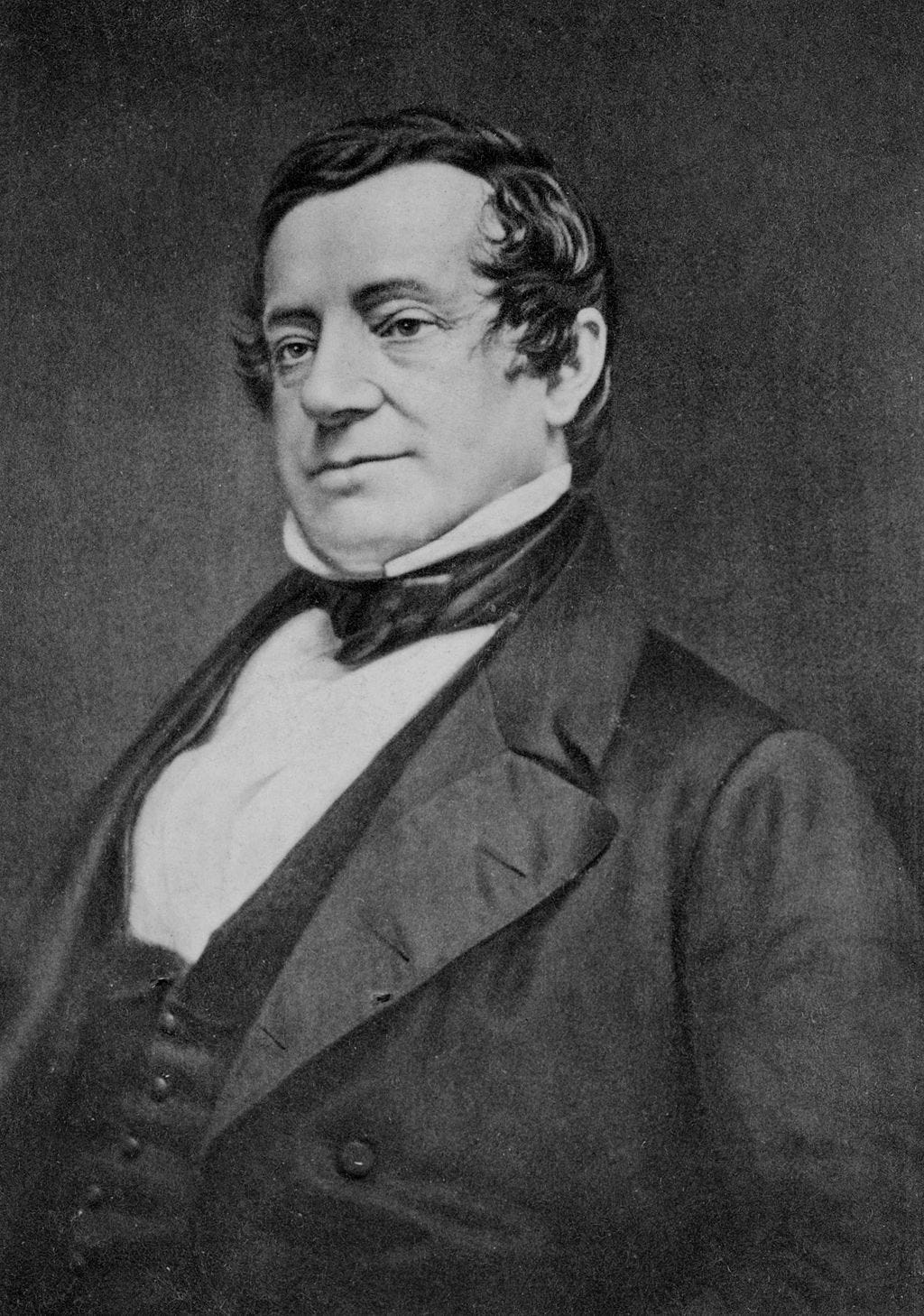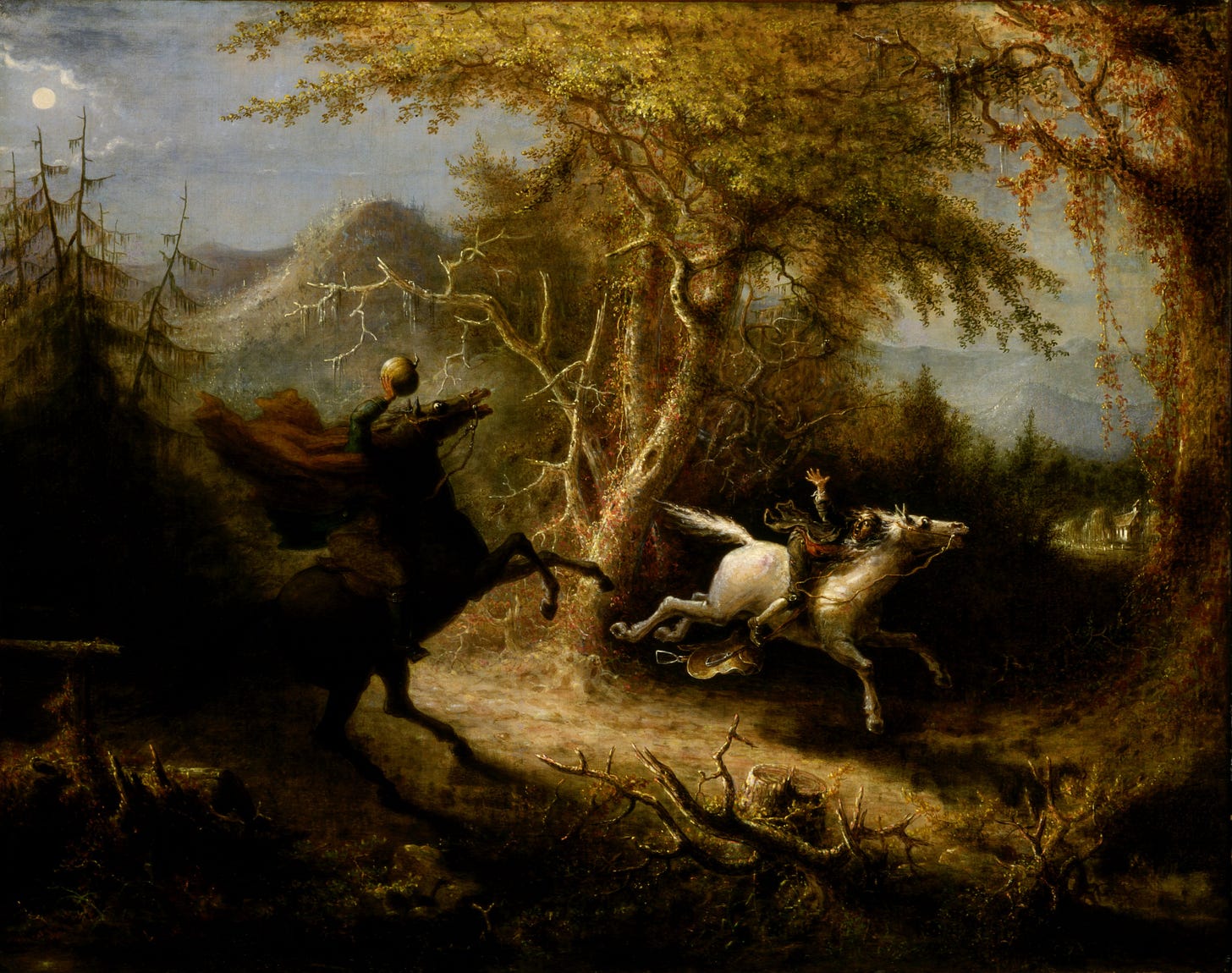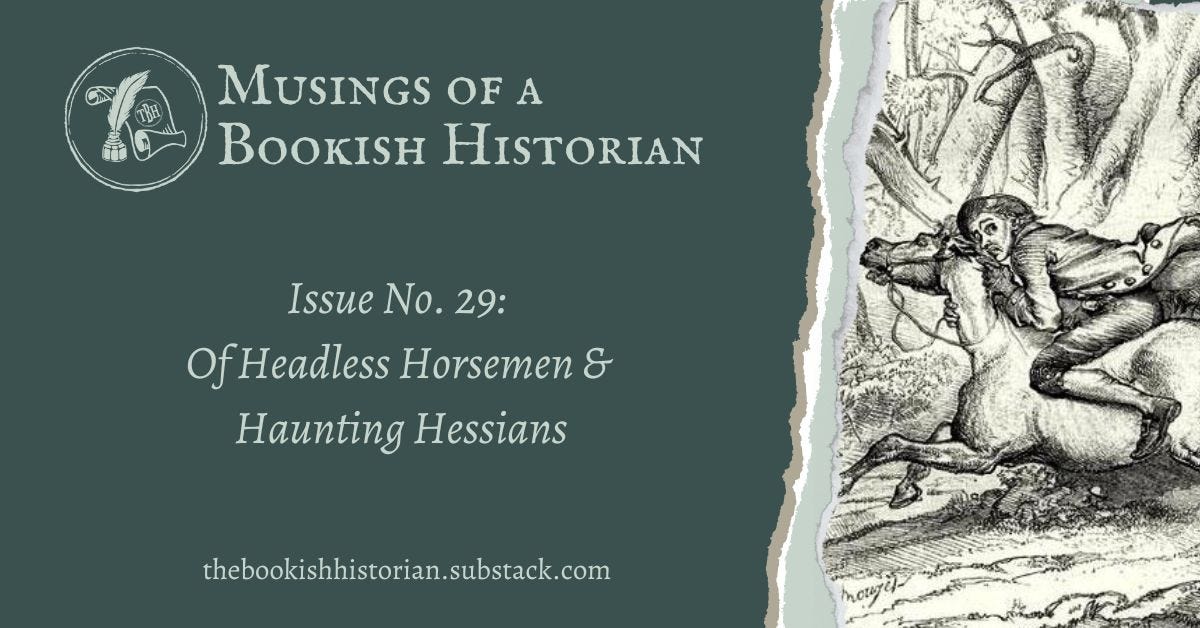Issue No. 29: Of Headless Horsemen & Haunting Hessians
"The Legend of Sleepy Hollow", a German soldier, and the birth of one of America's spookiest autumn tales
It’s not known, however, if he based the Headless Horseman on a particular soldier or story. What we do know is that the character forms an indelible part of our Halloween traditions, one that spawns derivative works, movies, and television shows.
Ah, it’s my favorite time of year! I love the falling leaves and vibrant colors, apple everything!, hoodie weather, a cozy fireplace, a blanket, headless horsemen…
Wait, headless horsemen? Yes, you read that right! The topic of this week’s issue is American author Washington Irving’s “The Legend of Sleepy Hollow”. Many of us have read this short story, or have watched any of the innumerable adaptations. But how much do you really know about it? I’ll share some context about the story’s history and its historical context. To put you in the mood on this Tuesday before Halloween, listen to this song from the Disney movie The Adventures of Ichabod Crane and Mr. Toad.
“The Legend of Sleepy Hollow” & Its Roots in the American Revolution
Related Artifact: The Headless Horseman Pursuing Ichabod Crane
“The Legend of Sleepy Hollow” & Its Roots in the American Revolution
Brief Synopsis of “The Legend of Sleepy Hollow”
For those unfamiliar with the 1820 American short story “The Legend of Sleepy Hollow”, let me borrow the synopsis from Encyclopedia Britannica:
The protagonist of the story, Ichabod Crane, is a Yankee schoolteacher who lives in Sleepy Hollow, a Dutch enclave on the Hudson River [in New York]. A suggestible man, Crane believes the ghost stories and tales of witchcraft he has heard and read. He is particularly impressed by the tale of a spectral headless horseman said to haunt the area. Crane is also mercenary; he courts Katrina Van Tassel mostly because she is the daughter of a rich farmer and is expected to receive a large inheritance.
Abraham Van Brunt (also called Brom Bones) is Crane’s jealous rival, a local favorite and a rash horseman who often plays tricks on the schoolmaster. Late one night as Crane rides home from a party at Van Tassel’s home, he is suddenly frightened by a ghostlike headless horseman. The ghost pursues him and hurls at him a round object that he takes to be a head but is later revealed to have been a pumpkin. The schoolmaster is never seen in Sleepy Hollow again.1
Irving leaves the story’s ending deliberately vague, leaving it up to the reader’s imagination to decide Crane’s fate. Does he survive, fleeing Sleepy Hollow in terror? Or did something more sinister occur? I believe, my friend, that is up to you.
Who was Washington Irving?
Born in New York, Washington Irving (1783-1859) was one of the preeminent authors in 19th-century America, the “first American to win critical praise for his writing in England”.2 Irving’s writing repertoire includes not only “The Legend of Sleepy Hollow” but also “Rip Van Winkle,” a story about a man who falls asleep for twenty years.

Irving initially pursued his passion for writing through corresponding for his brother’s newspaper The Morning Chronicle.3 He decided to fully embrace writing as a career. Over the years, he wrote for The Sketch Book of Geoffrey Crayon and moved into biographies, including one written about America’s first president, George Washington. He passed away on November 28, 1859.
We remember Irving for his wit and ability to craft memorable stories that changed the course of American literature.
“The Legend of Sleepy Hollow” & the Headless Hessian
In the opening paragraphs of “The Legend of Sleepy Hollow”, Irving places us firmly in the “sequestered glen” of Sleepy Hollow in 1790, just over a decade after the end of the American Revolution.4 The United States had just finalized its divorce from England and was slowly coming to terms with what that separation might mean. During the war, Sleepy Hollow, situated in Westchester County, New York, remained effectively neutral, but “this distinction created conditions ripe for violence and left the county’s civilian population…vulnerable”.5
It’s within this context, then, that Irving envisioned his headless horseman. A degenerate, dangerous, petrifying being amongst a tranquil, pastoral place:
The dominant spirit, however, that haunts this enchanted place…is the apparition of a figure on horseback, without a head. It is said by some to be the ghost of a Hessian trooper, whose head had been carried away by a cannon-ball, in some nameless battle during the Revolutionary War…6
So, why Hessians? These soldiers from the German state of Hesse-Cassel played a key role during the American Revolution. The British hired approximately 30,000 of these soldiers, and they gained a reputation for their brutal efficiency and a penchant for looting.7 Given Hessian propensity towards violence and their association with the British, it stands to reason that Irving drew inspiration from them for his spectral menace.
It’s not known, however, if he based the Headless Horseman on a particular soldier or story.8 What we do know is that the character forms an indelible part of our Halloween traditions, one that spawns derivative works, movies, and television shows.
Suggested Reading: “The Legend of Sleepy Hollow”
It probably comes as no surprise that I chose the tale of “The Legend of Sleepy Hollow” as suggested reading for this week. This short story, written in 1820, appeared in The Sketch Book of Geoffrey Canyon, written while Irving resided in Birmingham, England.
Fortunately, the story can easily be found in the public domain, and I’ve included a link to the story on Project Gutenberg below.
Related Artifact: The Headless Horseman Pursuing Ichabod Crane
Of all of the artworks I’ve seen depicting “The Legend of Sleepy Hollow”, John Quidor’s painting ranks among my favorite. A distinct Gothic air permeates the scene as the Headless Horseman, mounted on a frenzied coal-black horse, relentlessly pursues Ichabod Crane, seated on a panicked white horse. The contrast between these two colors - black and white - as well as Quidor’s brilliant use of light and dark, heighten the painting’s drama and tension.

Artifact Description
Title: The Headless Horseman Pursuing Ichabod Crane
Artist: John Quidor
Medium: Oil on canvas
Date: 1858
Collection: Smithsonian American Art Museum
Featured image: Ichabod pursued by the Headless Horseman, by F.O.C. Darley (Public domain)
The Editors of Encyclopedia Britannica, “The Legend of Sleepy Hollow,” Encyclopedia Britannica, https://www.britannica.com/topic/The-Legend-of-Sleepy-Hollow (accessed October 29, 2024).
Daniel G. Hoffman, “Irving’s Use of American Folklore in ‘The Legend of Sleepy Hollow’, PMLA 68, no. 3 (June 1953), 425, https://www.jstor.org/stable/459863.
“Washington Irving,” Washington Library Center for Digital History, https://mountvernon.org/library/digitalhistory/digital-encyclopedia/article/washington-irving (accessed October 29, 2024).
Washington Irving, The Legend of Sleepy Hollow, ed. Ilana M. Kingsley Newby and Greg Newby, Project Gutenberg, https://www.gutenberg.org/files/41/41-h/41-h.htm (accessed October 29, 2024).
Katherine Egner Gruber, “The Legend of Sleepy Hollow: Hidden History in an American Ghost Story,” Jamestown-Yorktown Foundation, https://www.jyfmuseums.org/Home/Components/News/News/84/ (accessed October 29, 2024).
Irving, Sleepy Hollow.
Gruber, “Hidden History”; David Head, “Hessians,” Washington Library Center for Digital History, https://www.mountvernon.org/library/digitalhistory/digital-encyclopedia/article/hessians (accessed October 29, 2024).
Many have speculated, however, that the Headless Horseman possibly derives from the “headless rider” figure from German literature, or from a corpse of a headless man found in the aftermath of the Battle of White Plains in October 1776.








Well done! Oh, dear, but may I pick a few nits? Prior to Washington Irving, Charles Brockden Brown’s work gained traction in Europe, and I think Irving would call Brown our first national literary treasure. Oh fiddlesticks, I hate sounding critical. Thank you very much for bringing the Hessian angle of the story into focus. It wasn’t so much about their place of origin or heritage as it was what they did for England that got them such a bad rap. I remember hearing a speaker years ago who mentioned that almost anyone from anywhere who wanted to privateer for the Brits got a Hessian uniform. I was also told that some signed up just to get to the colonies, and then deserted or outright defected. I have the notes of that lecture around here somewhere. Anyway, I adore your style, and the depth of your focus. The only other thing (the ole lady said timidly) I would point out is that prior to the Sketchbook, Irving became quite popular with his satirical History of New York under the guise F. Knickerbocker, a character whose opinions were often opposite his own. He and his brother at first researched to create a serious work, but his brother went on to business opportunities and well, Irving couldn’t resist putting his own special spin on their research. This attention to the history of his home state of course also informed The Sketchbook.
So interesting and in depth. I really enjoyed reading your article.